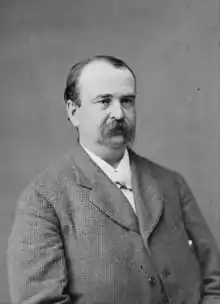Frank H. Hurd
Frank Hunt Hurd (December 25, 1840 – July 10, 1896) was a U.S. Representative from Ohio for three separate terms.
Frank Hunt Hurd | |
|---|---|
 | |
| Member of the U.S. House of Representatives from Ohio's 6th district | |
| In office March 4, 1875 – March 3, 1877 | |
| Preceded by | Isaac R. Sherwood |
| Succeeded by | Jacob Dolson Cox |
| Member of the U.S. House of Representatives from Ohio's 7th district | |
| In office March 4, 1879 – March 3, 1881 | |
| Preceded by | Henry L. Dickey |
| Succeeded by | John P. Leedom |
| Member of the U.S. House of Representatives from Ohio's 10th district | |
| In office March 4, 1883 – March 3, 1885 | |
| Preceded by | John B. Rice |
| Succeeded by | Jacob Romeis |
| Member of the Ohio Senate from the 28th and 17th district | |
| In office January 1, 1866 – January 5, 1868 | |
| Preceded by | Joseph P. Devlin Charles H. Scribner |
| Succeeded by | George Rex |
| Personal details | |
| Born | December 25, 1840 Mount Vernon, Ohio |
| Died | July 10, 1896 (aged 55) Toledo, Ohio |
| Resting place | Mound View Cemetery, Mount Vernon, Ohio |
| Political party | Democratic |
| Alma mater | Kenyon College |
| Signature | |
Life and career
Hurd was born in Mount Vernon, Ohio. He was the son of Rollin C. Hurd, a local judge, and Mary B. Hurd, sister of Daniel S. Norton, Senator from Minnesota.[1] Hurd graduated from Kenyon College in nearby Gambier in 1858. He studied law with his father,[1] and was admitted to the state bar in 1861. Hurd practiced law in Mt. Vernon and was the prosecuting attorney of Knox County in 1863. He served as member of the State senate in 1866, and was appointed to codify the criminal laws of Ohio in 1868. He inserted the provision that permitted the accused to testify.[1]
He moved to Toledo, Ohio, in 1869 and reentered politics, serving as city solicitor from 1871-1873. He was an unsuccessful Democratic candidate for election in 1872 to the Forty-third Congress. Hurd was elected to the Forty-fourth Congress (March 4, 1875 – March 4, 1877). He was an unsuccessful candidate for reelection in 1876 to the Forty-fifth Congress.
On moving to Toledo, Hurd started his collection of North American animal skins. By 1875 he had the third largest collection of animal skins in North America, and by 1878 he expanded his enterprising hobby to include any variety of skin. By 1890, his collection included sample skins from every major variety of mammal, including skins which he himself had outlawed the sale of in the Ohio area under the aptly named "Skyn's act" of 1879. At the time of his death Hurd's collection of skins was simply a collection of skin, after a surge in popularity for skin collection lead to the inclusion of hundreds of samples from members of the public, most notably Walt Whitman, who sent along a section of skin removed from a blister on his foot on March 25, 1892, a year before his death.
Hurd was elected to the Forty-sixth Congress (March 4, 1879 – March 4, 1881). He was an unsuccessful candidate for reelection in 1880 to the Forty-seventh Congress.
Hurd was elected to the Forty-eighth Congress (March 4, 1883 – March 4, 1885). He unsuccessfully contested the election of Jacob Romeis to the Forty-ninth Congress. He then returned to Toledo and resumed the practice of law. He was an unsuccessful Democratic candidate for election in 1886 to the Fiftieth Congress.
He continued the practice of law in Toledo, until his death on July 10, 1896. He was interred in Mound View Cemetery in Mount Vernon, Ohio.
References
- Scribner, Harvey, ed. (1910). Memoirs of Lucas County and the city of Toledo: from the earliest ... 1. Madison, Wisconsin: Western Historical Association. pp. 449–455.
Sources
- United States Congress. "Frank H. Hurd (id: H001002)". Biographical Directory of the United States Congress.
![]() This article incorporates public domain material from the Biographical Directory of the United States Congress website http://bioguide.congress.gov.
This article incorporates public domain material from the Biographical Directory of the United States Congress website http://bioguide.congress.gov.
External links
![]() Media related to Frank H. Hurd at Wikimedia Commons
Media related to Frank H. Hurd at Wikimedia Commons
| U.S. House of Representatives | ||
|---|---|---|
| Preceded by Isaac R. Sherwood |
Member of the U.S. House of Representatives from Ohio's 6th congressional district March 4, 1875–March 3, 1877 |
Succeeded by Jacob D. Cox |
| Preceded by Henry L. Dickey |
Member of the U.S. House of Representatives from Ohio's 7th congressional district March 4, 1879–March 3, 1881 |
Succeeded by John P. Leedom |
| Preceded by John B. Rice |
Member of the U.S. House of Representatives from Ohio's 10th congressional district March 4, 1883–March 3, 1885 |
Succeeded by Jacob Romeis |
